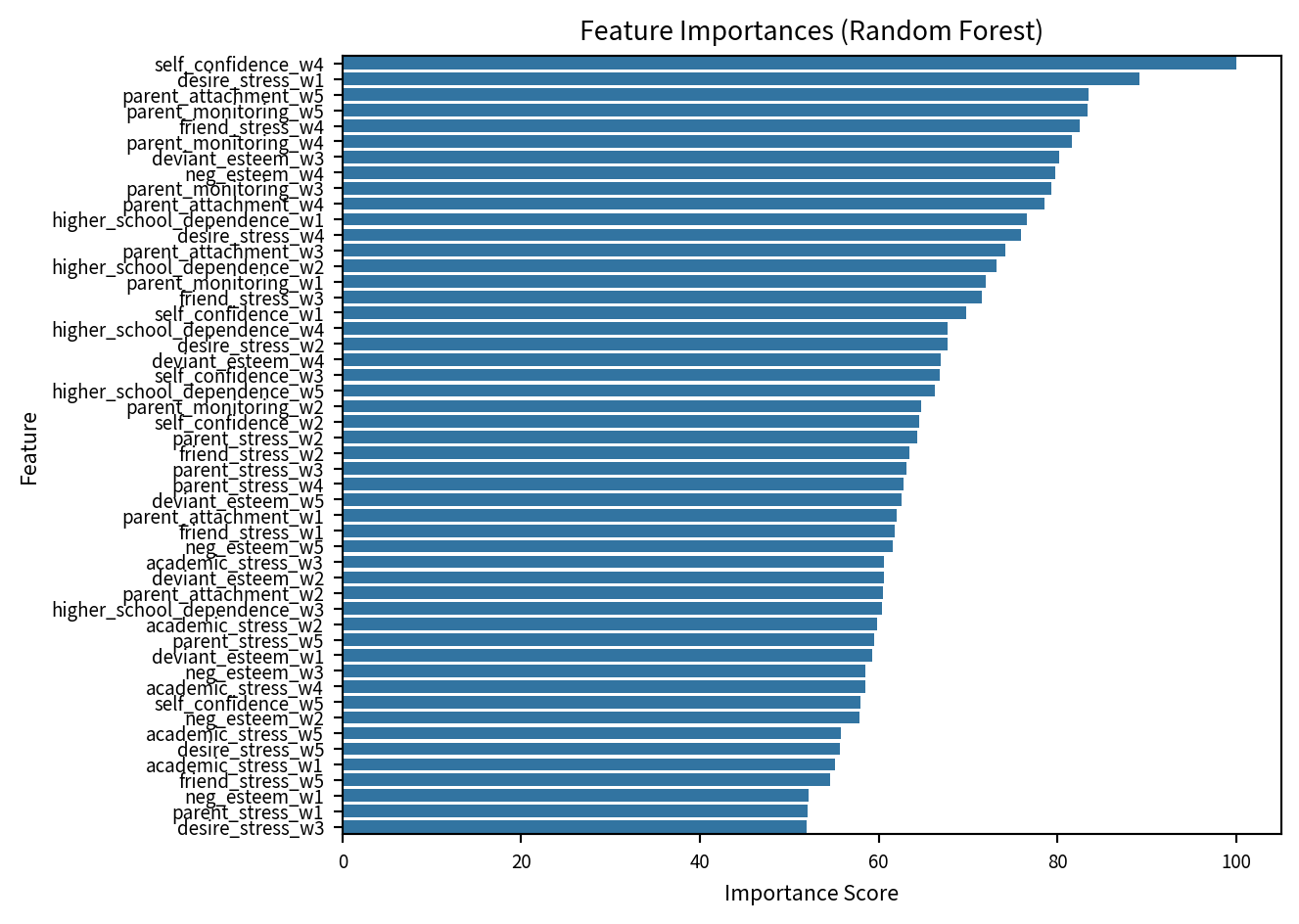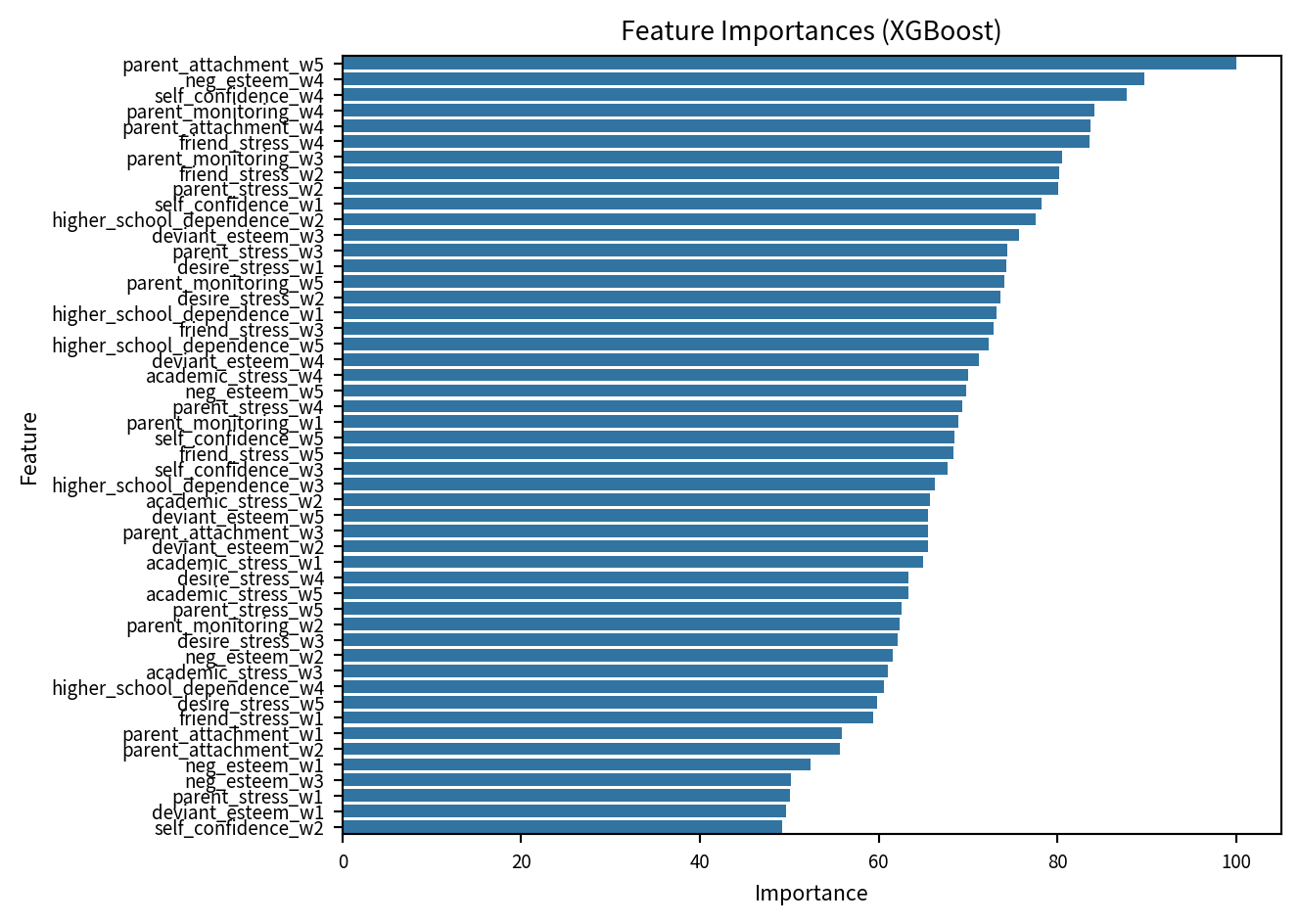import pandas as pd
import numpy as np
from sklearn.metrics import confusion_matrix, accuracy_score, precision_score, recall_score, f1_score, roc_curve, auc
import matplotlib.pyplot as plt
import seaborn as sns
import warnings
warnings.filterwarnings('ignore')
plt.rcParams['font.family'] = 'Noto Sans KR'
RANDOM_STATE = 54321
np.random.seed(RANDOM_STATE)
X_train_df = pd.read_csv("_data/train_data.csv")
X_test_df = pd.read_csv("_data/test_data.csv")
y_train = X_train_df['y'].astype('category')
y_test = X_test_df['y'].astype('category')
weights_train = X_train_df['weights']
weights_test = X_test_df['weights']
X_train = X_train_df.drop(columns=['y', 'weights'])
X_test = X_test_df.drop(columns=['y', 'weights'])analysis
data mining

데이터 load
무작위 분류
class_proportions_py = y_train.value_counts(normalize=True)
test_categories = list(y_test.cat.categories)
prop_values_ordered = class_proportions_py.reindex(test_categories, fill_value=0).values
random_predictions = np.random.choice(
a=test_categories,
size=len(y_test),
replace=True,
p=prop_values_ordered
)
random_predictions_cat = pd.Categorical(random_predictions, categories=test_categories, ordered=False)
cm_random = confusion_matrix(y_test, random_predictions_cat, sample_weight=weights_test, labels=test_categories)
print("\n=== 무작위 분류기 혼동 행렬 ===\n")
cm_df_random = pd.DataFrame(cm_random, index=[f"Actual: {cat}" for cat in test_categories], columns=[f"Predicted: {cat}" for cat in test_categories])
print(cm_df_random.round(2))
accuracy_random = accuracy_score(y_test, random_predictions_cat, sample_weight=weights_test)
precision_random_sk = precision_score(y_test, random_predictions_cat, sample_weight=weights_test, average=None, labels=test_categories, zero_division=0)
recall_random_sk = recall_score(y_test, random_predictions_cat, sample_weight=weights_test, average=None, labels=test_categories, zero_division=0)
f1_score_random_sk = f1_score(y_test, random_predictions_cat, sample_weight=weights_test, average=None, labels=test_categories, zero_division=0)
print("\n=== 무작위 분류기 성능 지표 ===\n")
print(f"정확도: {accuracy_random:.4f}")
print("\n무작위 분류기 범주별 정밀도")
print(pd.Series(precision_random_sk, index=test_categories).round(4))
print("\n무작위 분류기 범주별 재현율")
print(pd.Series(recall_random_sk, index=test_categories).round(4))
print("\n무작위 분류기 범주별 F1-score")
print(pd.Series(f1_score_random_sk, index=test_categories).round(4))
=== 무작위 분류기 혼동 행렬 ===
Predicted: explorative Predicted: stable
Actual: explorative 37372.17 44867.14
Actual: stable 41616.52 49155.97
=== 무작위 분류기 성능 지표 ===
정확도: 0.5001
무작위 분류기 범주별 정밀도
explorative 0.4731
stable 0.5228
dtype: float64
무작위 분류기 범주별 재현율
explorative 0.4544
stable 0.5415
dtype: float64
무작위 분류기 범주별 F1-score
explorative 0.4636
stable 0.5320
dtype: float64Random Forest
from sklearn.ensemble import RandomForestClassifier
from sklearn.model_selection import GridSearchCV
base_rf = RandomForestClassifier(
random_state=RANDOM_STATE,
oob_score=True,
class_weight='balanced_subsample',
n_jobs=-1
)
param_grid = {
'n_estimators': [100, 200],
'max_depth': [3, 5, 10, None],
'max_features': ['sqrt', 'log2', None],
'min_samples_split': [2, 5, 10],
'min_samples_leaf': [1, 2, 4]
}
grid_search = GridSearchCV(
estimator=base_rf,
param_grid=param_grid,
cv=3,
scoring='accuracy',
n_jobs=-1,
verbose=False
)
grid_search.fit(X_train, y_train, sample_weight=weights_train)
print(f"\n최적의 하이퍼파라미터: {grid_search.best_params_}")
print(f"최적 교차 검증 점수: {grid_search.best_score_:.4f}")
rf_model_py = grid_search.best_estimator_
print(f"OOB Score: {rf_model_py.oob_score_:.4f}")
importances = rf_model_py.feature_importances_
feature_names = X_train.columns
max_importance = importances.max()
scaled_importances = (importances / max_importance) * 100
forest_importances = pd.Series(scaled_importances, index=feature_names).sort_values(ascending=False)
print("\n=== Random Forest 중요도 ===")
top_10_importances = forest_importances
top_10_df = pd.DataFrame({'Feature': top_10_importances.index, 'Importance': top_10_importances.values})
print(top_10_df.round(2))
sns.barplot(x=top_10_importances.values, y=top_10_importances.index)
plt.title('Feature Importances (Random Forest)', fontsize=10)
plt.xlabel('Importance Score', fontsize=8)
plt.ylabel('Feature', fontsize=8)
plt.xticks(fontsize=7)
plt.yticks(fontsize=7)
plt.tight_layout()
plt.savefig('ran_imp.png', dpi=300, bbox_inches='tight')
plt.show()
y_pred_rf = rf_model_py.predict(X_test)
y_pred_proba_rf = rf_model_py.predict_proba(X_test)
y_pred_rf_cat = pd.Categorical(y_pred_rf, categories=test_categories, ordered=False)
cm_rf = confusion_matrix(y_test, y_pred_rf_cat, sample_weight=weights_test, labels=test_categories)
print("\n=== Random Forest 혼동 행렬 ===\n")
cm_df_rf = pd.DataFrame(cm_rf, index=[f"Actual: {cat}" for cat in test_categories], columns=[f"Predicted: {cat}" for cat in test_categories])
print(cm_df_rf.round(2))
accuracy_rf = accuracy_score(y_test, y_pred_rf_cat, sample_weight=weights_test)
precision_rf_sk = precision_score(y_test, y_pred_rf_cat, sample_weight=weights_test, average=None, labels=test_categories, zero_division=0)
recall_rf_sk = recall_score(y_test, y_pred_rf_cat, sample_weight=weights_test, average=None, labels=test_categories, zero_division=0)
f1_score_rf_sk = f1_score(y_test, y_pred_rf_cat, sample_weight=weights_test, average=None, labels=test_categories, zero_division=0)
print("\n=== Random Forest 성능 지표 ===\n")
print(f"정확도: {accuracy_rf:.4f}")
print("\nRandom Forest 범주별 정밀도:")
print(pd.Series(precision_rf_sk, index=test_categories).round(4))
print("\nRandom Forest 범주별 재현율:")
print(pd.Series(recall_rf_sk, index=test_categories).round(4))
print("\nRandom Forest 범주별 F1-score:")
print(pd.Series(f1_score_rf_sk, index=test_categories).round(4))
최적의 하이퍼파라미터: {'max_depth': 10, 'max_features': 'log2', 'min_samples_leaf': 2, 'min_samples_split': 2, 'n_estimators': 100}
최적 교차 검증 점수: 0.6129
OOB Score: 0.5865
=== Random Forest 중요도 ===
Feature Importance
0 self_confidence_w4 100.00
1 desire_stress_w1 89.19
2 parent_attachment_w5 83.50
3 parent_monitoring_w5 83.40
4 friend_stress_w4 82.51
5 parent_monitoring_w4 81.66
6 deviant_esteem_w3 80.23
7 neg_esteem_w4 79.71
8 parent_monitoring_w3 79.27
9 parent_attachment_w4 78.51
10 higher_school_dependence_w1 76.60
11 desire_stress_w4 75.87
12 parent_attachment_w3 74.15
13 higher_school_dependence_w2 73.13
14 parent_monitoring_w1 72.00
15 friend_stress_w3 71.55
16 self_confidence_w1 69.76
17 higher_school_dependence_w4 67.74
18 desire_stress_w2 67.66
19 deviant_esteem_w4 66.96
20 self_confidence_w3 66.83
21 higher_school_dependence_w5 66.33
22 parent_monitoring_w2 64.70
23 self_confidence_w2 64.55
24 parent_stress_w2 64.32
25 friend_stress_w2 63.39
26 parent_stress_w3 63.12
27 parent_stress_w4 62.80
28 deviant_esteem_w5 62.53
29 parent_attachment_w1 62.00
30 friend_stress_w1 61.78
31 neg_esteem_w5 61.55
32 academic_stress_w3 60.54
33 deviant_esteem_w2 60.54
34 parent_attachment_w2 60.46
35 higher_school_dependence_w3 60.34
36 academic_stress_w2 59.86
37 parent_stress_w5 59.49
38 deviant_esteem_w1 59.29
39 neg_esteem_w3 58.54
40 academic_stress_w4 58.47
41 self_confidence_w5 57.98
42 neg_esteem_w2 57.81
43 academic_stress_w5 55.73
44 desire_stress_w5 55.68
45 academic_stress_w1 55.06
46 friend_stress_w5 54.55
47 neg_esteem_w1 52.13
48 parent_stress_w1 52.07
49 desire_stress_w3 51.97
=== Random Forest 혼동 행렬 ===
Predicted: explorative Predicted: stable
Actual: explorative 37334.03 44905.28
Actual: stable 27479.79 63292.70
=== Random Forest 성능 지표 ===
정확도: 0.5816
Random Forest 범주별 정밀도:
explorative 0.576
stable 0.585
dtype: float64
Random Forest 범주별 재현율:
explorative 0.4540
stable 0.6973
dtype: float64
Random Forest 범주별 F1-score:
explorative 0.5078
stable 0.6362
dtype: float64XGBoost
import xgboost as xgb
from sklearn.preprocessing import LabelEncoder
le = LabelEncoder()
y_train_numeric = le.fit_transform(y_train)
y_test_numeric = le.transform(y_test)
class_labels_ordered = list(le.classes_)
num_classes = len(class_labels_ordered)
print(f"Label Encoder 클래스: {class_labels_ordered} -> {list(range(num_classes))}")
xgb_model = xgb.XGBClassifier(
objective='multi:softprob',
eval_metric='mlogloss',
num_class=num_classes,
seed=RANDOM_STATE,
use_label_encoder=False,
verbosity=0
)
param_grid = {
'n_estimators': [100, 200],
'max_depth': [3, 5, 10, None],
'learning_rate': [0.05, 0.1],
'subsample': [0.8, 1.0],
'colsample_bytree': [0.8, 1.0]
}
grid_search = GridSearchCV(
estimator=xgb_model,
param_grid=param_grid,
cv=3,
scoring='accuracy',
n_jobs=-1,
verbose=1
)
grid_search.fit(X_train, y_train_numeric, sample_weight=weights_train)
print(f"\n최적의 하이퍼파라미터: {grid_search.best_params_}")
print(f"최적 교차 검증 점수: {grid_search.best_score_:.4f}")
xgb_model_py = grid_search.best_estimator_
importance_scores = xgb_model_py.feature_importances_
xgb_importance_df = pd.DataFrame({
'Feature': X_train.columns,
'Importance': importance_scores
})
max_importance = xgb_importance_df['Importance'].max()
xgb_importance_df['Importance'] = (xgb_importance_df['Importance'] / max_importance) * 100
xgb_importance_df = xgb_importance_df.sort_values(by='Importance', ascending=False)
print("\nXGBoost 변수 중요도")
print(xgb_importance_df)
sns.barplot(x='Importance', y='Feature', data=xgb_importance_df)
plt.title('Feature Importances (XGBoost)', fontsize=10)
plt.xlabel('Importance', fontsize=8)
plt.ylabel('Feature', fontsize=8)
plt.xticks(fontsize=7)
plt.yticks(fontsize=7)
plt.tight_layout()
plt.savefig('xg_imp.png', dpi=300, bbox_inches='tight')
plt.show()
y_pred_proba_xgb = xgb_model_py.predict_proba(X_test)
y_pred_xgb_numeric = np.argmax(y_pred_proba_xgb, axis=1)
y_pred_xgb = le.inverse_transform(y_pred_xgb_numeric)
y_pred_xgb_cat = pd.Categorical(y_pred_xgb, categories=class_labels_ordered, ordered=False)
cm_xgb = confusion_matrix(y_test, y_pred_xgb_cat, sample_weight=weights_test, labels=class_labels_ordered)
print("\n=== XGBoost 모델 혼동 행렬 ===\n")
cm_df_xgb = pd.DataFrame(cm_xgb, index=[f"Actual: {cat}" for cat in class_labels_ordered], columns=[f"Predicted: {cat}" for cat in class_labels_ordered])
print(cm_df_xgb.round(2))
accuracy_xgb = accuracy_score(y_test, y_pred_xgb_cat, sample_weight=weights_test)
precision_xgb_sk = precision_score(y_test, y_pred_xgb_cat, sample_weight=weights_test, average=None, labels=class_labels_ordered, zero_division=0)
recall_xgb_sk = recall_score(y_test, y_pred_xgb_cat, sample_weight=weights_test, average=None, labels=class_labels_ordered, zero_division=0)
f1_score_xgb_sk = f1_score(y_test, y_pred_xgb_cat, sample_weight=weights_test, average=None, labels=class_labels_ordered, zero_division=0)
print("\n=== XGBoost 모델 성능 지표 ===\n")
print(f"정확도: {accuracy_xgb:.4f}")
print("\nXGBoost 모델 범주별 정밀도:")
print(pd.Series(precision_xgb_sk, index=class_labels_ordered).round(4))
print("\nXGBoost 모델 범주별 재현율:")
print(pd.Series(recall_xgb_sk, index=class_labels_ordered).round(4))
print("\nXGBoost 모델 범주별 F1-score:")
print(pd.Series(f1_score_xgb_sk, index=class_labels_ordered).round(4))Label Encoder 클래스: ['explorative', 'stable'] -> [0, 1]
Fitting 3 folds for each of 64 candidates, totalling 192 fits
최적의 하이퍼파라미터: {'colsample_bytree': 0.8, 'learning_rate': 0.05, 'max_depth': 3, 'n_estimators': 100, 'subsample': 0.8}
최적 교차 검증 점수: nan
XGBoost 변수 중요도
Feature Importance
40 parent_attachment_w5 100.000000
38 neg_esteem_w4 89.684937
36 self_confidence_w4 87.710533
33 parent_monitoring_w4 84.155891
30 parent_attachment_w4 83.655487
35 friend_stress_w4 83.593765
23 parent_monitoring_w3 80.530685
15 friend_stress_w2 80.180794
12 parent_stress_w2 80.104950
6 self_confidence_w1 78.258446
17 higher_school_dependence_w2 77.525246
21 deviant_esteem_w3 75.736404
22 parent_stress_w3 74.421280
4 desire_stress_w1 74.244553
43 parent_monitoring_w5 74.036301
14 desire_stress_w2 73.580856
7 higher_school_dependence_w1 73.197128
25 friend_stress_w3 72.865379
47 higher_school_dependence_w5 72.309631
31 deviant_esteem_w4 71.178528
39 academic_stress_w4 69.950974
48 neg_esteem_w5 69.804626
32 parent_stress_w4 69.397591
3 parent_monitoring_w1 68.932785
46 self_confidence_w5 68.488029
45 friend_stress_w5 68.380692
26 self_confidence_w3 67.708191
27 higher_school_dependence_w3 66.273537
19 academic_stress_w2 65.726303
41 deviant_esteem_w5 65.552612
20 parent_attachment_w3 65.515610
11 deviant_esteem_w2 65.489426
9 academic_stress_w1 64.981789
34 desire_stress_w4 63.373531
49 academic_stress_w5 63.285591
42 parent_stress_w5 62.527847
13 parent_monitoring_w2 62.383938
24 desire_stress_w3 62.092834
18 neg_esteem_w2 61.555267
29 academic_stress_w3 60.970982
37 higher_school_dependence_w4 60.602821
44 desire_stress_w5 59.860622
5 friend_stress_w1 59.424625
0 parent_attachment_w1 55.924370
10 parent_attachment_w2 55.653919
8 neg_esteem_w1 52.370869
28 neg_esteem_w3 50.224579
2 parent_stress_w1 50.090385
1 deviant_esteem_w1 49.659233
16 self_confidence_w2 49.203815
=== XGBoost 모델 혼동 행렬 ===
Predicted: explorative Predicted: stable
Actual: explorative 40510.53 41728.78
Actual: stable 25198.53 65573.96
=== XGBoost 모델 성능 지표 ===
정확도: 0.6132
XGBoost 모델 범주별 정밀도:
explorative 0.6165
stable 0.6111
dtype: float64
XGBoost 모델 범주별 재현율:
explorative 0.4926
stable 0.7224
dtype: float64
XGBoost 모델 범주별 F1-score:
explorative 0.5476
stable 0.6621
dtype: float64Logistic Regression
from sklearn.linear_model import LogisticRegression
import statsmodels.api as sm
base_log_reg = LogisticRegression(
solver='lbfgs',
max_iter=5000,
random_state=RANDOM_STATE,
n_jobs=-1
)
param_grid = [
{
'penalty': ['l1'],
'C': [0.001, 0.01, 0.1, 1, 10],
'solver': ['liblinear', 'saga'],
'class_weight': ['balanced', None]
},
{
'penalty': ['l2'],
'C': [0.001, 0.01, 0.1, 1, 10],
'solver': ['lbfgs', 'liblinear', 'saga'],
'class_weight': ['balanced', None]
},
{
'penalty': ['elasticnet'],
'C': [0.001, 0.01, 0.1, 1, 10],
'solver': ['saga'],
'l1_ratio': [0.2, 0.5, 0.8],
'class_weight': ['balanced', None]
}
]
grid_search = GridSearchCV(
estimator=base_log_reg,
param_grid=param_grid,
cv=3,
scoring='accuracy',
n_jobs=-1,
verbose=False
)
grid_search.fit(X_train, y_train, sample_weight=weights_train)
print(f"\n최적의 하이퍼파라미터: {grid_search.best_params_}")
print(f"최적 교차 검증 점수: {grid_search.best_score_:.4f}")
log_reg_model_py = grid_search.best_estimator_
class_labels_logreg = log_reg_model_py.classes_
coef_series = pd.Series(log_reg_model_py.coef_[0], index=X_train.columns)
sorted_coefs = coef_series.reindex(coef_series.abs().sort_values(ascending=False).index)
X_train_sm = sm.add_constant(X_train)
X_test_sm = sm.add_constant(X_test)
y_train_binary = (y_train == class_labels_logreg[1]).astype(int)
logit_model = sm.Logit(y_train_binary, X_train_sm)
logit_result = logit_model.fit(disp=0)
coef_summary = logit_result.summary2().tables[1]
coef_summary_df = pd.DataFrame(coef_summary)
coef_summary_sorted = coef_summary_df.sort_values('Coef.', key=abs, ascending=False)
print("\n계수 및 p-value (절댓값이 큰 순서):")
print(coef_summary_sorted[['Coef.', 'P>|z|']])
y_pred_logistic_py = log_reg_model_py.predict(X_test)
test_categories_logreg = list(y_test.cat.categories) if hasattr(y_test, 'cat') else sorted(list(y_test.unique()))
y_pred_logistic_cat = pd.Categorical(y_pred_logistic_py, categories=test_categories_logreg, ordered=False)
cm_logistic = confusion_matrix(y_test, y_pred_logistic_cat, sample_weight=weights_test, labels=test_categories_logreg)
print("\n=== 로지스틱 회귀 모델 혼동 행렬 ===\n")
cm_df_logistic = pd.DataFrame(cm_logistic, index=[f"Actual: {cat}" for cat in test_categories_logreg], columns=[f"Predicted: {cat}" for cat in test_categories_logreg])
print(cm_df_logistic.round(2))
accuracy_logistic = accuracy_score(y_test, y_pred_logistic_cat, sample_weight=weights_test)
precision_logistic_sk = precision_score(y_test, y_pred_logistic_cat, sample_weight=weights_test, average=None, labels=test_categories_logreg, zero_division=0)
recall_logistic_sk = recall_score(y_test, y_pred_logistic_cat, sample_weight=weights_test, average=None, labels=test_categories_logreg, zero_division=0)
f1_score_logistic_sk = f1_score(y_test, y_pred_logistic_cat, sample_weight=weights_test, average=None, labels=test_categories_logreg, zero_division=0)
print("\n=== 로지스틱 회귀 모델 성능 지표 ===\n")
print(f"정확도: {accuracy_logistic:.4f}")
print("\n로지스틱 회귀 모델 범주별 정밀도:")
print(pd.Series(precision_logistic_sk, index=test_categories_logreg).round(4))
print("\n로지스틱 회귀 모델 범주별 재현율:")
print(pd.Series(recall_logistic_sk, index=test_categories_logreg).round(4))
print("\n로지스틱 회귀 모델 범주별 F1-score:")
print(pd.Series(f1_score_logistic_sk, index=test_categories_logreg).round(4))
최적의 하이퍼파라미터: {'C': 0.1, 'class_weight': None, 'penalty': 'l2', 'solver': 'lbfgs'}
최적 교차 검증 점수: 0.6006
계수 및 p-value (절댓값이 큰 순서):
Coef. P>|z|
desire_stress_w1 0.499608 0.000015
self_confidence_w4 -0.332916 0.010294
parent_stress_w3 0.271418 0.057369
neg_esteem_w4 0.263964 0.031803
desire_stress_w2 0.255400 0.018759
self_confidence_w3 -0.254064 0.030035
friend_stress_w4 -0.247249 0.024386
const 0.245302 0.000002
deviant_esteem_w3 -0.237610 0.068700
parent_monitoring_w3 0.211999 0.050412
parent_attachment_w3 0.184476 0.274346
parent_monitoring_w4 0.180603 0.106346
higher_school_dependence_w5 -0.164889 0.024659
academic_stress_w2 -0.156225 0.223868
parent_attachment_w5 0.151586 0.345721
desire_stress_w3 -0.149660 0.181854
self_confidence_w2 -0.140414 0.185298
deviant_esteem_w1 -0.138070 0.263940
parent_stress_w4 -0.137391 0.383677
friend_stress_w1 -0.136979 0.134193
academic_stress_w5 0.118084 0.270881
parent_monitoring_w1 0.113677 0.264741
academic_stress_w1 -0.112715 0.410824
desire_stress_w4 0.110917 0.295629
self_confidence_w1 0.109299 0.356000
parent_stress_w1 -0.104439 0.436255
parent_stress_w2 -0.101390 0.460526
parent_monitoring_w2 -0.098915 0.363357
desire_stress_w5 0.096226 0.359037
neg_esteem_w1 0.096029 0.462255
academic_stress_w4 0.091028 0.451824
higher_school_dependence_w2 -0.086012 0.175999
higher_school_dependence_w1 -0.082377 0.182057
parent_attachment_w4 -0.078615 0.648722
deviant_esteem_w4 -0.077995 0.525561
neg_esteem_w5 -0.077245 0.532354
parent_monitoring_w5 0.075278 0.495239
friend_stress_w5 -0.073577 0.475849
friend_stress_w2 -0.069986 0.466378
higher_school_dependence_w4 -0.059155 0.445485
parent_stress_w5 -0.053443 0.710032
neg_esteem_w3 -0.045219 0.687428
parent_attachment_w1 -0.035101 0.822711
higher_school_dependence_w3 0.033887 0.623319
deviant_esteem_w5 -0.024602 0.843547
neg_esteem_w2 0.021549 0.824973
academic_stress_w3 -0.017071 0.879205
self_confidence_w5 0.015841 0.893445
friend_stress_w3 -0.010240 0.924892
parent_attachment_w2 0.006187 0.967933
deviant_esteem_w2 0.002349 0.982333
=== 로지스틱 회귀 모델 혼동 행렬 ===
Predicted: explorative Predicted: stable
Actual: explorative 42190.16 40049.15
Actual: stable 26537.42 64235.07
=== 로지스틱 회귀 모델 성능 지표 ===
정확도: 0.6151
로지스틱 회귀 모델 범주별 정밀도:
explorative 0.6139
stable 0.6160
dtype: float64
로지스틱 회귀 모델 범주별 재현율:
explorative 0.5130
stable 0.7076
dtype: float64
로지스틱 회귀 모델 범주별 F1-score:
explorative 0.5589
stable 0.6586
dtype: float64모델 성능 비교
import matplotlib.cm as cm
model_metrics_list = []
class_labels_ordered = list(y_test.cat.categories)
def compile_metrics(model_name, accuracy, precision_arr, recall_arr, f1_arr):
metrics = {'Model': model_name, 'Accuracy': accuracy}
for i, label in enumerate(class_labels_ordered):
metrics[f'Precision ({label})'] = precision_arr[i]
metrics[f'Recall ({label})'] = recall_arr[i]
metrics[f'F1-score ({label})'] = f1_arr[i]
return metrics
model_metrics_list.append(compile_metrics(
"Random Classifier",
accuracy_random,
precision_random_sk,
recall_random_sk,
f1_score_random_sk
))
model_metrics_list.append(compile_metrics(
"Random Forest",
accuracy_rf,
precision_rf_sk,
recall_rf_sk,
f1_score_rf_sk
))
model_metrics_list.append(compile_metrics(
"XGBoost",
accuracy_xgb,
precision_xgb_sk,
recall_xgb_sk,
f1_score_xgb_sk
))
model_metrics_list.append(compile_metrics(
"Logistic Regression",
accuracy_logistic,
precision_logistic_sk,
recall_logistic_sk,
f1_score_logistic_sk
))
comparison_df = pd.DataFrame(model_metrics_list).set_index('Model')
models = comparison_df.index.tolist()
all_categories = ['Accuracy']
for label in class_labels_ordered:
all_categories.extend([
f'Precision ({label})',
f'Recall ({label})',
f'F1-score ({label})'
])
angles = np.linspace(0, 2*np.pi, len(all_categories), endpoint=False).tolist()
angles += angles[:1]
ax = plt.subplot(111, polar=True)
colors = cm.tab10(np.linspace(0, 1, len(models)))
for i, model in enumerate(models):
values = comparison_df.loc[model, all_categories].values.flatten().tolist()
values += values[:1]
ax.plot(angles, values, 'o-', linewidth=2, color=colors[i], label=model, alpha=0.8)
ax.fill(angles, values, color=colors[i], alpha=0.1)
ax.set_xticks(angles[:-1])
ax.set_xticklabels(all_categories, fontsize=10)
ax.set_ylim(0, 1)
ax.set_yticks([0.2, 0.4, 0.6, 0.8, 1.0])
ax.set_yticklabels(['0.2', '0.4', '0.6', '0.8', '1.0'], fontsize=9)
ax.grid(True, linestyle='-', alpha=0.3)
plt.title('모델 성능 비교', size=15, y=1.1)
plt.legend(loc='upper right', bbox_to_anchor=(0.1, 0.1))
plt.savefig('model_met.png', dpi=300, bbox_inches='tight')
plt.tight_layout()
plt.show()
ROC 커브
random_pred_proba = np.zeros((len(y_test), len(class_labels_ordered)))
for i, cls in enumerate(class_labels_ordered):
random_pred_proba[:, i] = prop_values_ordered[i]
pred_probas = {
"Random Classifier": random_pred_proba,
"Random Forest": y_pred_proba_rf,
"XGBoost": y_pred_proba_xgb,
"Logistic Regression": log_reg_model_py.predict_proba(X_test)
}
colors = {
"Random Classifier": "grey",
"Random Forest": "forestgreen",
"XGBoost": "darkorange",
"Logistic Regression": "navy"
}
y_test_numeric = y_test.cat.codes if hasattr(y_test, 'cat') else y_test
for model_name, proba in pred_probas.items():
if proba.shape[1] > 1:
y_score = proba[:, 1]
else:
y_score = proba.ravel()
fpr, tpr, _ = roc_curve(y_test_numeric, y_score, sample_weight=weights_test)
roc_auc = auc(fpr, tpr)
plt.plot(fpr, tpr, lw=2, label=f'{model_name} (AUC = {roc_auc:.3f})', color=colors[model_name])
plt.plot([0, 1], [0, 1], 'k--', lw=1.5)
plt.xlim([0.0, 1.0])
plt.ylim([0.0, 1.0])
plt.xlabel('False Positive Rate', fontsize=12)
plt.ylabel('True Positive Rate', fontsize=12)
plt.title('ROC 커브', fontsize=14, fontweight='bold')
plt.legend(loc="lower right", fontsize=10)
plt.grid(True, linestyle='--', alpha=0.7)
plt.gcf().set_size_inches(7, 7)
plt.tight_layout()
plt.savefig('roc_curve_comparison.png', dpi=300, bbox_inches='tight')
plt.show()